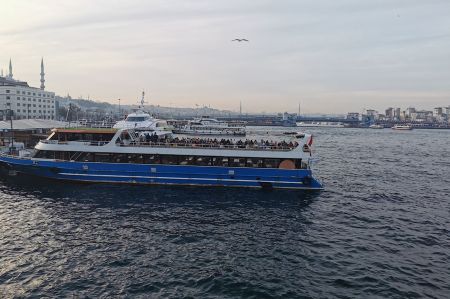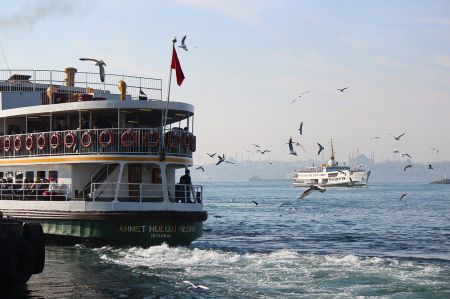Old historic Istanbul - enjoying sunset in Eminönü
- Written by Portal Editor
How one imagines Istanbul in one's dreams: Sunrise over the Bosphorus. The yellowish light is reflected in the water of the Golden Horn, which divides the new and old parts of Istanbul in the Eminonu district.
Eminönü is a predominantly commercial waterfront area of Istanbul within the Fatih district near the confluence of the Golden Horn with the southern entrance of the Bosphorus strait and the Sea of Marmara. It is connected to Karaköy (historic Galata) via the Galata Bridge across the Golden Horn. It was administered as part of the Sultanahmet district from 1928 to 2009 when Sultanahmet was absorbed into Fatih.
Eminonu is an important transport hub

Eminönü is an important transport hub. Several ferries have terminals along the Eminönü waterfront and the T1 tram has a stop here.
To the southeast Eminönü runs into Sirkeci, while to the northwest it merges with the shopping areas of Tahtakale and Küçükpazar. Inland from Emiõnü is another shopping district, Mahmutpaşa.
In Turkish, Eminönü means 'in front of justice' ('emin' meaning 'justice' and 'önü' meaning 'in front of'). The name probably came from the Ottoman courts and customs houses on the docks; "Emin" was the title of an Ottoman customs official.
The "Rüstern Pasa Mosque" and the Sirkeci railway station

We took the bus to get to Eminonu, a major hub for trains, trams, buses and ferries.
Besides the huge transport hub, the visit should include the Egyptian (Spice) Bazaar, the New Mosque, the "Rüstern Pasa Mosque" and the Sirkeci Railway Station. A great base for exploring old Istanbul.
First, we decided to take a ride on the Bosphorus. It was relaxing to sit in the wind and enjoy the view.
Ride on ferry boat crossing Bosphorus
Back in Eminönü, we walked along the embankment to Gülhane Park, which used to be part of the royal parks of Topkapi Palace and is now used by the people and visitors of Istanbul.
The Topkapı Palace (Ottoman Topkapı Sarayı, German 'Cannon Gate Palace') in Istanbul, in German also Topkapi Palace or Topkapi Seraglio, was for centuries the residence and seat of government of the sultans and the administrative center of the Ottoman Empire.
Beyazıt Square (Beyazıt Meydanı)
In 1478 a defensive wall was completed at a distance around the palace, which u. a. formed the space for today's first courtyard. The main features of the basic structure of the palace were thus already laid down in the 15th century. The building is thus one of the most important architectural testimonies of the Renaissance epoch in Europe, even after the later modifications.
The new Dolmabahçe Sarayı
The palace does not consist of a single building, but, true to Turkish tradition, consists of several buildings in a large garden. With an area of over 69 hectares and up to 5000 residents, the palace was a city in its own right. It was initially called Saray-ı Cedîd-i Âmire / or Yeni Saray 'New Palace', before the name Topkapı Sarayı, derived from the palace's cannon foundry, prevailed in the 18th century.
Panoramic view of Istanbul, the Bosphorus and the Golden Horn
Crossing the park, at its end we reached the Sultanahmet area, which means the historical centre of Istanbul. Here the Topkapi Palace, the Hagia Sophia, the Blue Mosque (Sultan Ahmed Mosque), the Hypodrome, the Sunken Cistern Palace (Basilica Cistern), the Archaeological Museum and the Grand (Covered) Bazaar lie close together.
A first tour that was able to leave deep impressions.
Please read as well:
